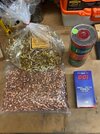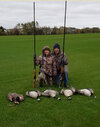Palladan44
Member
- Joined
- Nov 7, 2020
- Messages
- 1,903
Let's talk efficiency.
Obviously barrel length comes into play as well, but I wonder what handload (powder, bullet) fired out of what gun (barrel length) gives the most ft/lb of energy per grain of powder, and thus is the most efficient cartridge/firearm combo....
I'd have to think a bolt action carbine (so no gassing)of some sort, maybe 9mm w/115gr bullet loaded with a faster powder, maybe high nitroglycerin content....maybe bullseye.
Interesting thought.
Obviously barrel length comes into play as well, but I wonder what handload (powder, bullet) fired out of what gun (barrel length) gives the most ft/lb of energy per grain of powder, and thus is the most efficient cartridge/firearm combo....
I'd have to think a bolt action carbine (so no gassing)of some sort, maybe 9mm w/115gr bullet loaded with a faster powder, maybe high nitroglycerin content....maybe bullseye.
Interesting thought.
Last edited:



